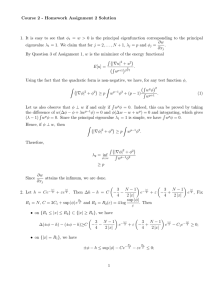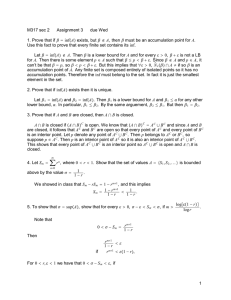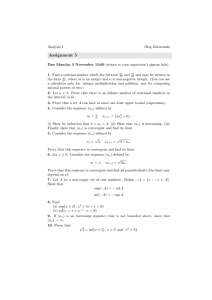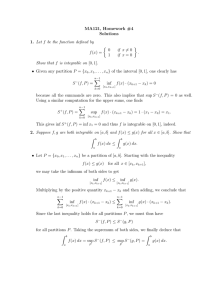LECTURE 8 LECTURE OUTLINE Reading: Sections 1.6, 4.1, 4.2 •
advertisement
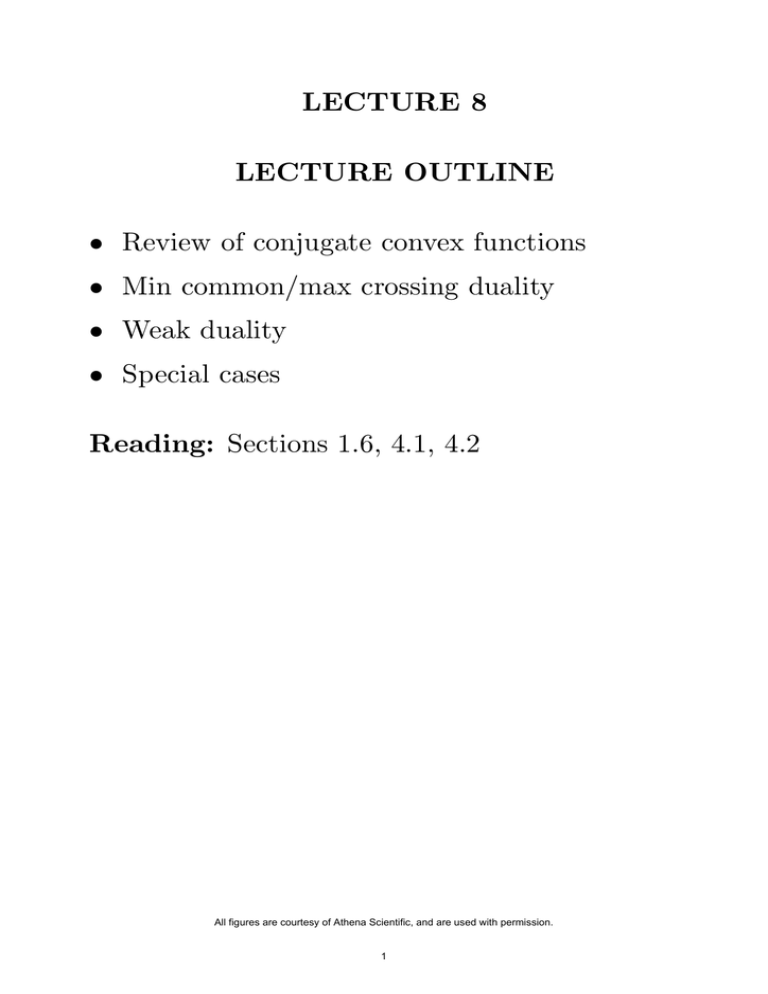
LECTURE 8
LECTURE OUTLINE
• Review of conjugate convex functions
• Min common/max crossing duality
• Weak duality
• Special cases
Reading: Sections 1.6, 4.1, 4.2
All figures are courtesy of Athena Scientific, and are used with permission.
1
CONJUGACY THEOREM
⇤
⌅
�
f (y) = sup x y − f (x) ,
y ⌘ �n
x⌦�n
f (x) = sup
y⌦�n
⇤
y� x
⌅
− f (y) ,
x ⌘ �n
• If f is closed convex proper, then f
= f.
f (x)
( y, 1)
Slope = y
�
f (x) = sup y � x
⇥
f (y)
y⇥⇤n
x
y�x
�
Hyperplane
H = (x, w) | w
x� y =
0
inf {f (x)
f (y)
x⇥⇤n
2
x� y} =
f (y)
⇥
f (y)
A FEW EXAMPLES
• lp and lq norm conjugacy, where
n
1
p
+
1
q
=1
n
1⌧
f (x) =
|xi |p ,
p i=1
1⌧
f (y) =
|yi |q
q i=1
• Conjugate of a strictly convex quadratic
1 �
f (x) = x Qx + a� x + b,
2
1
f (y) = (y − a)� Q−1 (y − a) − b.
2
• Conjugate of a function obtained by invertible
linear transformation/translation of a function p
�
⇥
f (x) = p A(x − c) + a� x + b,
f (y) = q
�
(A� )−1 (y
⇥
− a) + c� y + d,
where q is the conjugate of p and d = −(c� a + b).
3
SUPPORT FUNCTIONS
• Conjugate of indicator function ⌅X of set X
↵X (y) = sup y � x
x⌦X
is called the support function of X.
• To determine ↵X (y) for a given vector y, we
project the set X on the line determined by y,
we find x̂, the extreme point of projection in the
direction y, and we scale by setting
↵X (y) = �x̂� · �y �
X
x̂
y
0
X (y)/
y
• epi(↵X ) is a closed convex cone.
�
⇥
• The sets X, cl(X), conv(X), and cl conv(X)
all have the same support function (by the conjugacy theorem).
4
SUPPORT FN OF A CONE - POLAR CONE
• The conjugate of the indicator function ⌅C is
the support function, ↵C (y) = supx⌦C y � x.
• If C is a cone,
↵C (y) =
�
0
⇣
if y � x ⌥ 0, x ⌘ C,
otherwise
i.e., ↵C is the indicator function ⌅C ⇤ of the cone
C ⇤ = {y | y � x ⌥ 0, x ⌘ C}
This is called the polar cone of C.
⇤
• By� the Conjugacy
Theorem
the
polar
cone
of
C
⇥
is cl conv(C) . This is the Polar Cone Theorem.
�
⇥
• Special case: If C = cone {a1 , . . . , ar } , then
C ⇤ = {x | a�j x ⌥ 0, j = 1, . . . , r}
• Farkas’ Lemma: (C ⇤ )⇤ = C.
�
⇥
• True because C is a closed set [cone {a1 , . . . , ar }
is the image of the positive orthant {α | α ≥ 0}
under
the linear transformation that maps α to
�r
j=1 αj aj ], and the image of any polyhedral set
under a linear transformation is a closed set.
5
EXTENDING DUALITY CONCEPTS
• From dual descriptions of sets
A union of points
An intersection of halfspaces
• To dual descriptions of functions (applying
set duality to epigraphs)
( y, 1)
f (x)
Slope = y
0
x
infn {f (x)
x⇥⇤
x� y} =
f (y)
• We now go to dual descriptions of problems,
by applying conjugacy constructions to a simple
generic geometric optimization problem
6
MIN COMMON / MAX CROSSING PROBLEMS
• We introduce a pair of fundamental problems:
• Let M be a nonempty subset of �n+1
(a) Min Common Point Problem: Consider all
vectors that are common to M and the (n +
1)st axis. Find one whose (n + 1)st component is minimum.
(b) Max Crossing Point Problem: Consider nonvertical hyperplanes that contain M in their
“upper” closed halfspace. Find one whose
crossing point of the (n + 1)st axis is maximum.
.
w
6 .
M
% w
Min Common
/
%&'()*++*'(,*&'-(.
Point w
M
Min Common
/
Point w
%&'()*++*'(,*&'-(.
M
%
%
!0
Max Crossing /
%#0()1*22&'3(,*&'-(4
!0
u7
Max Crossing /
%#0()1*22&'3(,*&'-(4
Point q
Point q
(a)
"#$
(b)
"5$
w.
6
%M
Min Common /
%&'()*++*'(,*&'-(.
Point w
Max Crossing
/
Point q
%#0()1*22&'3(,*&'-(4
!0
(c)
"8$
7
9
M%
u7
u7
MATHEMATICAL FORMULATIONS
• Optimal value of min common problem:
w⇤ = inf w
(0,w)⌦M
w
(µ, 1)
M
(µ, 1)
M
w
q
Dual function value q(µ) =
0
inf
(u,w)⇤M
�
w + µ⇥ u}
�
⇥
Hyperplane Hµ, = (u, w) | w + µ⇥ u =
u
• Math formulation of max crossing problem: Focus on hyperplanes with normals (µ, 1)
whose crossing point ξ satisfies
ξ ⌥ w + µ� u,
(u, w) ⌘ M
Max crossing problem is to maximize ξ subject to
ξ ⌥ inf (u,w)⌦M {w + µ� u}, µ ⌘ �n , or
↵
maximize q(µ) =
(u,w)⌦M
subject to µ ⌘ �n .
8
inf
{w + µ� u}
GENERIC PROPERTIES – WEAK DUALITY
• Min common problem
inf
(0,w)⌦M
• Max crossing problem
↵
maximize q(µ) =
w
inf
(u,w)⌦M
{w + µ� u}
subject to µ ⌘ �n .
w
(µ, 1)
M
(µ, 1)
M
w
q
Dual function value q(µ) =
0
inf
(u,w)⇤M
�
w + µ⇥ u}
�
⇥
Hyperplane Hµ, = (u, w) | w + µ⇥ u =
u
• Note that q is concave and upper-semicontinuous
(inf of linear functions).
• Weak Duality: For all µ ⌘ �n
q(µ) =
inf
(u,w)⌦M
{w + µ� u} ⌥
inf
(0,w)⌦M
w = w⇤ ,
so maximizing over µ ⌘ �n , we obtain q ⇤ ⌥ w⇤ .
• We say that strong duality holds if q ⇤ = w⇤ .
9
CONNECTION TO CONJUGACY
• An important special case:
M = epi(p)
where p : �n ◆→ [−⇣, ⇣]. Then w⇤ = p(0), and
q(µ) =
inf
(u,w)⌦epi(p)
and finally
{w+µ� u} =
inf
{(u,w)|p(u)⌅w}
{w+µ� u},
⇤
⌅
�
q(µ) = inf p(u) + µ u
u⌦�m
(µ, 1)
p(u)
M = epi(p)
w = p(0)
q = p (0)
0
q(µ) =
• Thus, q(µ) = −p (−µ) and
q⇤
u
p ( µ)
⇤
⌅
= sup q(µ) = sup 0·(−µ)−p (−µ) = p (0)
µ⌦�n
µ⌦�n
10
GENERAL OPTIMIZATION DUALITY
• Consider minimizing a function f : �n ◆→ [−⇣, ⇣].
• Let F : �n+r ◆→ [−⇣, ⇣] be a function with
f (x) = F (x, 0),
x ⌘ �n
• Consider the perturbation function
p(u) = infn F (x, u)
x⌦�
and the MC/MC framework with M = epi(p)
• The min common value w⇤ is
w⇤ = p(0) = infn F (x, 0) = infn f (x)
x⌦�
x⌦�
• The dual function is
q(µ) = inf
u⌦�
r
⇤
p(u)+µ� u
⌅
=
inf n+r
(x,u)⌦�
⇤
F (x, u)+µ� u
so q(µ) = −F (0, −µ), where F is the conjugate
of F , viewed as a function of (x, u)
• We have
⌅
q ⇤ = sup q(µ) = − inf r F (0, −µ) = − inf r F (0, µ),
µ⌦�
µ⌦�r
µ⌦�
and weak duality has the form
w⇤ = infn F (x, 0) ≥ − inf r F (0, µ) = q ⇤
x⌦�
µ⌦�
11
CONSTRAINED OPTIMIZATION
• Minimize f : �n ◆→ � over the set
⇤
⌅
C = x ⌘ X | g(x) ⌥ 0 ,
where X ⌦ �n and g : �n ◆→ �r .
• Introduce a “perturbed constraint set”
⇤
⌅
Cu = x ⌘ X | g(x) ⌥ u ,
and the function
F (x, u) =
�
u ⌘ �r ,
f (x) if x ⌘ Cu ,
⇣
otherwise,
which satisfies F (x, 0) = f (x) for all x ⌘ C.
• Consider perturbation function
p(u) = infn F (x, u) =
x⌦�
inf
x⌦X, g(x)⌅u
f (x),
and the MC/MC framework with M = epi(p).
12
CONSTR. OPT. - PRIMAL AND DUAL FNS
• Perturbation function (or primal function)
p(u) =
inf
f (x),
x⌦X, g(x)⌅u
p(u)
M = epi(p)
�
(g(x), f (x)) | x
X
⇥
w = p(0)
q
0
u
• Introduce L(x, µ) = f (x) + µ� g(x). Then
⇤
⌅
⇧
q(µ) = inf
u⌥ r
=
u⌥
=
�
r
p(u) + µ u
inf
, x⌥X, g(x)⇤u
⇤
inf x⌥X L(x, µ)
−∞
13
⇧
f (x) + µ u
⌅
if µ ⌥ 0,
otherwise.
LINEAR PROGRAMMING DUALITY
• Consider the linear program
minimize c� x
subject to a�j x ≥ bj ,
j = 1, . . . , r,
where c ⌘ �n , aj ⌘ �n , and bj ⌘ �, j = 1, . . . , r.
• For µ ≥ 0, the dual function has the form
q(µ) = infn L(x, µ)
x⌦�
◆
r
⌫
⇠
⌧
µj (bj − a�j x)
= infn c� x +
x⌦�
j=1
�
�r
�
= b µ if j=1 aj µj = c,
−⇣ otherwise
• Thus the dual problem is
maximize b� µ
r
⌧
subject to
aj µj = c,
j =1
14
µ ≥ 0.
MIT OpenCourseWare
http://ocw.mit.edu
6.253 Convex Analysis and Optimization
Spring 2012
For information about citing these materials or our Terms of Use, visit: http://ocw.mit.edu/terms.


